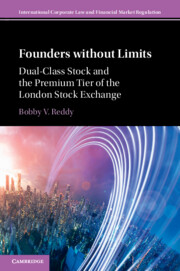Book contents
- Founders without Limits
- Cambridge University Press
- Founders without Limits
- Copyright page
- Contents
- Figures
- Tables
- Preface
- Acknowledgements
- Table of Cases
- Table of Legislation and Regulation
- Abbreviations
- Introduction
- Part I Putting Dual-Class Stock into Context
- 1 The Cult of Dual-Class Stock in the Era of Big Tech
- 2 A Tale of Two Cities and Beyond
- 3 First among Equals?
- 4 Shareholder Democracy and Corporate Purpose
- Part II Evaluating Dual-Class Stock
- Part III Formulating a Policy on Dual-Class Stock
- Appendix Comparison of Inferior-Voting Shareholder Protections on Major Dual-Class Stock Exchanges
- Index
1 - The Cult of Dual-Class Stock in the Era of Big Tech
from Part I - Putting Dual-Class Stock into Context
Published online by Cambridge University Press: 29 October 2021
- Founders without Limits
- Cambridge University Press
- Founders without Limits
- Copyright page
- Contents
- Figures
- Tables
- Preface
- Acknowledgements
- Table of Cases
- Table of Legislation and Regulation
- Abbreviations
- Introduction
- Part I Putting Dual-Class Stock into Context
- 1 The Cult of Dual-Class Stock in the Era of Big Tech
- 2 A Tale of Two Cities and Beyond
- 3 First among Equals?
- 4 Shareholder Democracy and Corporate Purpose
- Part II Evaluating Dual-Class Stock
- Part III Formulating a Policy on Dual-Class Stock
- Appendix Comparison of Inferior-Voting Shareholder Protections on Major Dual-Class Stock Exchanges
- Index
Summary
Chapter 1 sets the scene, highlighting the rise of US dual-class stock success stories in recent years, before contrasting it with the rules of the FCA, which prohibit dual-class stock from the London Stock Exchange’s most prestigious listing segment, the premium tier.Regulators fear that dual-class stock incentivises controllers to extract personal benefits to the detriment of shareholder value.However, there has been a significant decline of UK IPOs in recent years, with a severe dearth of large tech company listings, with high-growth companies and unicorns seeking private finance options instead.The United Kingdom is subject to disproportionate levels of takeover activities, and thriving British businesses are regularly being purchased by foreign acquirors.Dual-class stock could, though, encourage and promote the listing of high-growth companies, enabling founders to divest of equity and generate further equity finance for growth, while insulating the management team, and its pursuit of the founder’s long-term, idiosyncratic vision, from removal by public shareholders and takeovers if short-term profits are low.Although the standard tier listing of The Hut Group was a success, it entailed certain compromises which emphasise the importance of the premium tier, and dual-class stock could be the shot-in-the-arm to resuscitate what has become a moribund IPO market.
Keywords
- Type
- Chapter
- Information
- Founders without LimitsDual-Class Stock and the Premium Tier of the London Stock Exchange, pp. 15 - 69Publisher: Cambridge University PressPrint publication year: 2021



